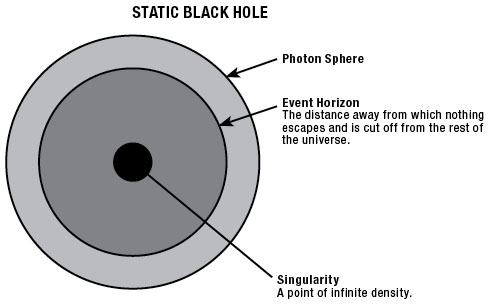BLACK HOLES
Extreme Gravity Sinks
Everybody’s heard of black holes. They’re popular in science-fiction literature and movies because they add great drama to the stories. In real life, black holes are pretty dramatic. So, what are they? Black holes are massive, dense objects with gravity so strong that nothing—not even light—can get out. That makes black holes themselves impossible to see. However, their effects can be detected. For example, activity around a black hole heats up its local environment, so astronomers can use instruments sensitive to infrared, x-rays, radio waves, and ultraviolet to trace what happens in the neighborhood of one of these cosmic monsters.

The anatomy of a black hole. The singularity is the infinitely dense heart of the black hole. The event horizon is the “point of no return” around a black hole. The photon sphere is the region where photons are constrained by gravity to orbit endlessly.
The Anatomy of a Black Hole
Stellar black holes form when an extremely massive star—say one at least twenty-five times the mass of the Sun—is blown apart in a supernova explosion. The leftover core collapses, and what’s left becomes a singularity—a hugely dense point in space that can contain many times the mass of the Sun. The properties of a black hole, including mass, help explain its behavior. In addition to mass, black holes also have an electric charge, and most have angular momentum, or spin, which comes from the original rotation of the star that collapsed. These properties can be measured from outside the black hole, but there is no way to know about the material inside the black hole. The boundary of a black hole is called the event horizon. That’s the region where the black hole’s gravitational pull is too strong for any incoming material or light to escape. An observer outside the black hole would not be able to detect anything happening inside the event horizon.
We can see objects and events occurring close to the event horizon. However, the extreme gravitational pull of the mass of the black hole slows down time, and the closer those objects and events are, the slower they appear to be moving. At the event horizon, they look like they are frozen in time, taking an infinite amount of time to disappear. If you were swirling into a black hole, time would pass completely normally for you. But your body would take a beating. If you fell toward it feet-first, your feet would be pulled more strongly than your head, and you would be stretched into a long, noodle-like object. This is called spaghettification. If you could survive the trip, you’d probably never notice exactly when you passed the event horizon. You would eventually make your way into the singularity, and your atoms would be crushed along with everything else that got caught in the black hole.
A rotating black hole can have what’s called an accretion disk around it. That’s a disk of material gradually being pulled into the black hole and is one of the ways that black holes grow. As this material (gas, dust, planets, stars) whirls around in the disk, it heats up by friction. The heat is radiated away, and the disk’s momentum is also funneled away through jets that stream perpendicular to the accretion disk. Activity in the disk and jets is very energetic and gives off strong emissions across the electromagnetic spectrum.
Supermassive Black Holes
The largest black holes live at the centers of galaxies and may play a role in shaping galaxies as they evolve. These supermassive black holes can have hundreds of thousands or millions of solar masses of material inside. They probably formed from black hole “seeds”—>stellar-mass black holes that formed when massive supergiant stars exploded as supernovae—or from intermediate-mass black holes that were created directly from the primordial gas in the early universe. The supermassive ones continued to accrete material, growing denser as time went by. Such a black hole at the center of a galaxy would have access to a lot of matter and could grow very massive.
There are several theories about the formation of these supermassive black holes. They may come from the collapse of dense stellar clusters. It’s also possible that central black holes may meld together during galaxy collisions. Even as astronomers find more and more black holes in galaxies, these strange cosmic beasts remain a fascinating and tantalizing area of study.